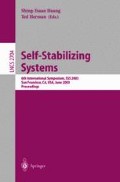Abstract
We define the “Pulse Synchronization” problem that requires nodes to achieve tight synchronization of regular pulse events, in the settings of distributed computing systems. Pulse-coupled synchronization is a phenomenon displayed by a large variety of biological systems, typically overcoming a high level of noise. Inspired by such biological models, a robust and self-stabilizing pulse synchronization algorithm for distributed computer systems is presented. The algorithm attains near optimal synchronization tightness while tolerating up to a third of the nodes exhibiting Byzantine behavior concurrently. We propose that pulse synchronization algorithms can be suitable for a variety of distributed tasks that require tight synchronization but which can tolerate a bound variation in the regularity of the synchronized pulse invocations.
This research was supported in part by Intel COMM Grant — Internet Network/Transport Layer & QoS Environment (IXA).
Access this chapter
Tax calculation will be finalised at checkout
Purchases are for personal use only
Preview
Unable to display preview. Download preview PDF.
References
A. Arora, S. Dolev, and M.G. Gouda, “Maintaining digital clocks in step”, Parallel Processing Letters, 1:11–18, 1991. 34
G. E. Andrews, “The Theory of Partitions”, Encyclopedia of Mathematics and Its Applications, Vol. 2, Addison-Wesley, Reading, MA, 1976.
J. Brzezinski, and M. Szychowiak, “Self-Stabilization in Distributed Systems-a Short Survey, Foundations of Computing and Decision Sciences, 25(1), 2000. 34
J. Buck, and E. Buck, “Synchronous fireflies”, Scientific American, Vol. 234, pp. 74–85, May 1976. 32
A. Daliot, D. Dolev, H. Parnas, “Self-Stabilizing Pulse Synchronization Inspired by Biological Pacemaker Networks Technical Report TR2003-1, Schools of Engineering and Computer Science, The Hebrew University of Jerusalem, March 2003. http://leibnitz.cs.huji.ac.il/tr/acc/2003/HUJI-CE-LTR-2003-1_pulse-tr6.ps 38, 40
D. Dolev, J. Halpern, and H. R. Strong, “On the Possibility and Impossibility of Achieving Clock Synchronization”, J. of Computer and Systems Science, Vol. 32:2, pp. 230–250, 1986. 41
D. Dolev, J. Y. Halpern, B. Simons, and R. Strong, “Dynamic Fault-Tolerant Clock Synchronization”, J. Assoc. Computing Machinery, Vol. 42, No.1, pp. 143–185, Jan. 1995. 33, 34, 41, 42
D. Dolev, N. A. Lynch, E. Stark, W. E. Weihl and S. Pinter, “Reaching Approximate Agreement in the Presence of Faults, Journal of the ACM, 33 (1986). 43
S. Dolev, “Self-Stabilization,” The MIT Press, 2000. 41
S. Dolev, and J. L. Welch, “Self-Stabilizing Clock Synchronization in the presence of Byzantine faults”, Proc. Of the Second Workshop on Self-Stabilizing Systems, pp. 9.1–9.12, 1995. 34, 41, 42
S Dolev and JL Welch, “Wait-free clock synchronization”, Algorithmica, 18(4):486–511, 1997. 34
C. Fetzer and F. Cristian, “An Optimal Internal Clock Synchronization Algorithm”, Proceedings of the 10th Conference on Computer Assurance, 1995, pp. 187–196, Gaithersburg, MD, USA. 33
W. O. Friesen, “Physiological anatomy and burst pattern in the cardiac ganglion of the spiny lobster Panulirus interuptus”, J. Comp. Physiol., Vol. 101, 1975. 32
W. O. Friesen, “Synaptic interaction in the cardiac ganglion of the spiny lobster Panulirus interuptus”, J. Comp. Physiol., Vol. 101, pp. 191–205, 1975. 32
M. J. Fischer, N. A. Lynch and M. Merritt, “Easy impossibility proofs for distributed consensus problems”, Distributed Computing, Vol. 1, pp. 26–39, 1986. 41
T. Herman, “Phase clocks for transient fault repair”, IEEE Transactions on Parallel and Distributed Systems, 11(10):1048–1057, 2000.
T. Herman and S. Ghosh, “Stabilizing Phase-Clocks”, Information Processing Letters, 5(6):585–598, 1994. 34
B. Liskov, “Practical Use of Synchronized Clocks in Distributed Systems”, PODC 10, 1991, pp. 1–9. 33
J. Lundelius, and N. Lynch, “An Upper and Lower Bound for Clock Synchronization,” Information and Control, Vol. 62, pp. 190–205, Aug/Sep. 1984. 42
N. Lynch, “Distributed Algorithms”, Morgan Kaufmann, 1996. 41
R. Mathar and J. Mattfeldt, “Pulse-coupled decentral synchronization”, SIAM J. Appl. Math, Vol. 56, No. 4, pp. 1094–1106, Aug. 1996. 44
R. E. Mirollo and S. H. Strogatz, “Synchronization of pulse-coupled biological oscillators”, SIAM J. Appl. Math, Vol. 50, pp. 1645–1662, 1990. 33
B. Patt-Shamir, “A Theory of Clock Synchronization, Doctoral thesis, MIT, Oct. 1994. 33
Z. Nèda, E. Ravasz, Y. Brechet, T. Vicsek, and A.-L. Barabàsi, “Self-organizing process: The sound of many hands clapping”, Nature, 403, pp. 849–850, 2000. 32
F. Schneider, “Understanding Protocols for Byzantine Clock Synchronization”, Technical Report 87-859, Dept. of Computer Science, Cornell University, 1987. 33
E. Sivan, H. Parnas and D. Dolev, “Fault tolerance in the cardiac ganglion of the lobster”, Biol. Cybern., Vol. 81, pp. 11–23, 1999. 32, 33
S. H. Strogatz and I. Stewart, “Coupled Oscillators and Biological Synchronization”, Scientific American, Vol. 269, pp. 102–109, Dec. 1993 32
A. S. Tanenbaum, “Computer Networks 3rd ed.”, Prentice Hall International. 4s4
Author information
Authors and Affiliations
Editor information
Editors and Affiliations
Rights and permissions
Copyright information
© 2003 Springer-Verlag Berlin Heidelberg
About this paper
Cite this paper
Daliot, A., Dolev, D., Parnas, H. (2003). Self-Stabilizing Pulse Synchronization Inspired by Biological Pacemaker Networks. In: Huang, ST., Herman, T. (eds) Self-Stabilizing Systems. SSS 2003. Lecture Notes in Computer Science, vol 2704. Springer, Berlin, Heidelberg. https://doi.org/10.1007/3-540-45032-7_3
Download citation
DOI: https://doi.org/10.1007/3-540-45032-7_3
Published:
Publisher Name: Springer, Berlin, Heidelberg
Print ISBN: 978-3-540-40453-8
Online ISBN: 978-3-540-45032-0
eBook Packages: Springer Book Archive

